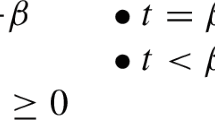Abstract
Peter Gärdenfors has developed a semantics for conditional logic, based on the operations of expansion and revision applied to states of information. The account amounts to a formalisation of the Ramsey test for conditionals. A conditional A > B is declared accepted in a state of information K if B is accepted in the state of information which is the result of revising K with respect to A. While Gärdenfors's account takes the truth-functional part of the logic as given, the present paper proposes a semantics entirely based on epistemic states and operations on these states. The semantics is accompanied by a syntactic treatment of conditional logic which is formally similar to Gentzen's sequent formulation of natural deduction rules. Three of David Lewis's systems of conditional logic are represented. The formulations are attractive by virtue of their transparency and simplicity.
Similar content being viewed by others
References
Gärdenfors, P., Knowledge in Flux, Cambridge, Mass., MIT Press, 1988.
Lewis, D. K. Counterfactuals, Oxford, Basil Blackwell, 1973.
Thomason, R. H, 'A Fitch-Style Formulation of Conditional Logic', Logique et Analyse 13 (1970), 397–412.
Author information
Authors and Affiliations
Rights and permissions
About this article
Cite this article
Roeper, P. A Sequent Formulation of Conditional Logic Based on Belief Change Operations. Studia Logica 77, 425–438 (2004). https://doi.org/10.1023/B:STUD.0000039033.21918.51
Issue Date:
DOI: https://doi.org/10.1023/B:STUD.0000039033.21918.51



